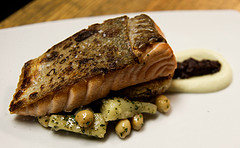
If you're like most people, salmon is probably a popular choice for you and your family when you get that craving for some fresh seafood. After all, salmon is one of the most versatile and prevalent fish available. But did you know that certain types of salmon are more sustainable than others?
Wild-caught salmon from Alaska is perhaps the most sustainable choice readily available in most of the United States. Fortunately, it is also one of the most flavorful kinds of salmon. Due to Alaska's excellent wildlife preservation, most of it's freshwater habitats haven't been affected by damming, deforestation, and development as much as the freshwater lakes and streams in California and the Pacific Northwest. If you can't find salmon from Alaska, other kinds of wild-caught salmon are a close second choice when it comes to sustainability.
Atlantic salmon found on the market in the United States is always farm-raised because wild salmon are increasingly rare in the Atlantic. The farming practices used to raise Atlantic salmon make it less sustainable, less flavorful, and less healthy than wild-caught alternatives. Farmed fish often require antibiotics and other chemicals to control the various diseases and parasites present in over-crowded fish pens. Not only are you paying for these chemicals when you buy Atlantic salmon, but they can also endanger nearby wild species of marine life if the farmed salmon escape their pens.
So next time you're thinking about picking up some salmon for dinner, do your body and the environment a favor and make sure you look for wild-caught salmon, especially from Alaska. For more information regarding sustainable seafood and supporting environmentally friendly fishing practices, you can visit the Marine Stewardship Council's website at http://www.msc.org.

